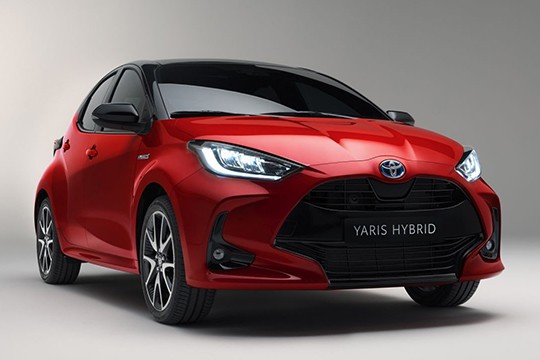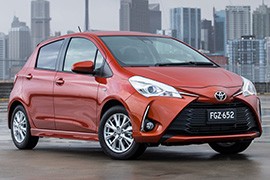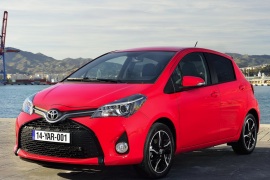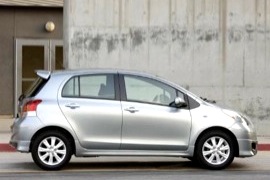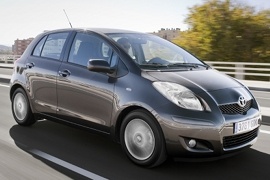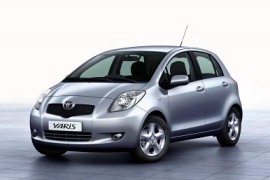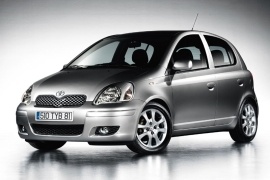TOYOTA Yaris 5 Doors Models/Series Timeline, Specifications & Photos
First production year: 1999
Engines: Hybrid gasoline, Gasoline, Diesel, Hybrid
Body style: Hatchback
Toyota refreshed the fourth generation of the Yaris in 2024 and added more power, improved styling, and a better interior for its supermini vehicle.
Thanks to its hybrids, Toyota managed to chase Volkswagen for first position in Europe’s car sales. Moreover, most of its cars were powered by electrified drivetrains, which helped the Japanese automaker. One of its most significant vehicles was the fourth generation of the Yaris, which was introduced in 2020. While that model suffered in sales due to the world pandemic and the microchip crisis that followed, it didn’t mean it didn’t need a facelift. The automaker did just that four years later, in February 2024, and surprised everyone. In times when many car manufacturers lowered their cars’ power to diminish their CO2 impact, the refreshed Yaris was more powerful and had polluted less than its predecessor.
The B-segment vehicle was available in several trim levels, including the sportier-looking GR, depending on the country. It boasted a broad grille on the lower bumper and was flanked by a pair of scoops that housed the fog lamps. It also sported a GR red and black badge on the horizontal slat that supported the license plate. The entire range benefited from new headlights underlined by LED daytime running lights.
From its profile, the 2024 Yaris impressed with its new design wheels, which were available in up to 18 inches in size. The standard version sat on 15-inch ones. Furthermore, Toyota offered customers the option to get the Yaris in two-tone paint with a black roof. The automaker tried to make the car look more aggressive, even though it was mostly an urban commuter vehicle. It installed new aerodynamic side sills that lowered the ground clearance. From behind, bystanders could see the new OLED taillights that formed C-shapes flanking the tailgate. Like its non-facelifted sibling, the 2024 Yaris sported a roof spoiler on the upper side of the tailgate. At the same time, the lower bumper featured a black diffuser that concealed the exhaust.
Inside, the automaker improved the car with updated technologies. Customers could get the Yaris with a choice of 7- or 12.3-inch digital instrument panel that fronted the driver. Atop the center stack, in a free-floating position, Toyota installed a standard 10.5-inch touchscreen, with an option for a 12.3-inch one for the High, Premiere Edition, and GR Sport grades. The car also featured Toyota’s newest infotainment system, which, besides touch controls, could be accessed via voice commands. Linking the car to the MyT app, customers could send commands to the vehicle while being outside. For instance, they could program the car to set the interior to a specific temperature.
Under the hood, the base version came with the same 116 PS (114 hp) drivetrain from its non-facelifted version. The most significant change for the 2024 Yaris was the improved powertrain that sent 130 PS (127 hp) to the front wheels. Toyota achieved this by installing a new hybrid transaxle fitted with a more powerful motor.
Toyota introduced the fourth generation of the Yaris in late 2019 simultaneously in Japan and Europe, and unlike its predecessors, it was available only as a five-door hatchback. Still, a high-performance three-door version came later and was known as the GR Yaris.
Right before the pandemic struck the world and forced everybody to lock themselves inside their homes, Toyota introduced the fourth generation of the successful model Yaris. The car was already known for its reliability. In addition, it was a user-friendly vehicle, and Toyota managed to keep these attributes on the 2020 Yaris.
This was one of the reasons why the Japanese automaker made the vehicle with five doors. It noticed that this bodywork version was in high demand on its predecessor, so it decided to slash the three-door option. As a result, it could keep production costs down while still offering plenty of features and amenities.
With a design that didn’t want to scare anyone on the road, the 2020 Yaris came clean in front of its customers with swept-back headlights and a massive front bumper that incorporated the broad, trapezoidal-shaped grille. In addition, Toyota installed a set of scoops on the sides of the front apron where it placed the fog lamps, which were on the options list. Otherwise, those were filled with fake air intakes. From its profile, depending on the grades, the Yaris sported body-colored door mirrors and door handles.
The sculptured doors created the image of a three-door vehicle since the rear ones were shorter and sported a raised rear area that emerged onto the C-pillars. At the back, the carmaker made the car with a tilted-forward tailgate adorned with a roof spoiler.
Inside, Toyota created a modern interior with a large screen for the infotainment system placed atop the center stack. In front of the driver, installed a mixed instrument cluster that featured large dials for the tachometer and the rev counter and, between them, an LCD for additional data provided by the car’s onboard computer.
Depending on trims and options, customers could get the car with power windows and air-conditioning. Furthermore, a powerful sound system was also on the options list. The bucket seats didn’t provide excellent side support, but they were comfortable despite their high-mounted position. In the back, the car manufacturer placed a split-folding (60/40) bench seat where two adults could sit comfortably. Still, for short jaunts, a third passenger could sit in the middle, but with limited legroom. The trunk featured a flat floor, but the overall volume was unimpressive.
Under the hood, the fourth generation of the Yaris came fitted with either gasoline-only or electrified versions. Surprisingly, it even offered the option for an automatic transmission (eCVT), but the base model sent its power to the front wheels via a six-speed manual.
After six years on the market, Toyota didn't rush to change its small-sized contender, Yaris, but added a second facelift for this third-generation model.
Maybe the biggest change in Yaris' history was the addition of this nameplate to the Australian market, where the vehicle was known as Echo. But that didn't change too much for the market, as the customers were already familiarized with the car's shape.
From the design point of view, the carmaker totally changed the front fascia. Its bulky front bumper sported a black, arched, center lower grille and body-colored sides, giving the impression of a catamaran. Even though this was no landbarge, it still created the image of a larger vehicle. The new headlights were available with LEDs for both high- and low beams for the upper trim levels. In the five-door version, the Yaris featured a blacked-out B-pillar, giving the impression of a three-door vehicle. Moreover, the car's ascending beltline also hosted the door handles. Thus, the rear ones were placed in an upper position than the front ones.
The interior boasted a new infotainment unit with steering-wheel buttons and a touch-screen mounted in the center stack above the climate control buttons. But the most significant change was on the safety side. Here, Toyota gave its small-segment contender Yaris many new features such as automatic headlights that could detect the oncoming traffic, seven airbags, brake-force assist, stability control, and most importantly, a pre-collision system that automatically braked the vehicle.
Under the hood, Toyota placed the same 1.3- and 1.5-liter gasoline engines for the European and the American market.
Toyota introduced a mid-life cycle refresh for its small-sized Yaris, trying to keep up with its competitors, such as the Volkswagen Polo and the Renault Clio.
While the Japanese carmaker was known for its reliable vehicles, it still had to struggle in the small-size segment. In Europe, it faced grueling competition from the German, French, Italian, and Spanish brands. Even though its customers were satisfied with the car, they still needed something more than just a nameplate; they needed a fresh look. And that's why Toyota came in 2014 with the upgraded version of the Yaris' third generation.
The most significant change in the car's appearance was at the front. Toyota didn't just add a line here and there and call it a day. The company's design team completely changed the front fascia, which now featured an X-shaped design emphasized by two chromed trims that ran across the grille and the lower bumper. In addition, the new headlights looked even sharper than before and were more extended to the sides. Finally, at the back, there was a new set of taillights, where the reversing lights were smaller than on the pre-facelifted version.
Inside, the dashboard was completely redesigned, and the driver's instrument binnacle has been restyled for a slimmer look. On the center stack, the carmaker offered an option for a 7" touch-screen display for the infotainment unit, up from the 6.1" of its predecessor. As for the interior decorations, the carmaker offered new upholstery and colors.
Under the hood, the carmaker kept some of its older engines but ditched the 1.6-liter turbo-diesel in favor of a smaller 1.4-liter unit. In addition, a new hybrid version was available.
The third generation of the Toyota Yaris was introduced in 2011 and it came to reinforce the Japanese car-maker presence in the European B-Segment.
The big competition for the small segment was high in Europe. The European traditional car-makers such as the French, Italians and German companies were hard to beat on their home ground. The 2011 Yaris delivered an ingenious combination of benefits, with hi-tech on-board equipment and decent engine offers.
When compared to its predecessor, the 2011 Yaris grew with 100 mm (3.9”) and half of the increase was in the wheelbase. The bold frontal look identified the Yaris as the first vehicle to feature the new face of the Toyota family. The key frontal styling was the change in the proportions of the upper and lower grilles. The taillights were placed into an angled position, at the mid-section of the tailgate. The trunk was larger than on its predecessor by 25%. The three seats in the back are OK for adult passengers and the access was easy through the large rear doors.
Inside the vehicle, there were more than enough amenities for the B-segment car. A climate control, on-board computer, and a sound system. The latter could have been upgraded to a genuine infotainment unit that featured the Toyota Touch multimedia base unit. Using a compatible smartphone, via Bluetooth, the system offered on-board connectivity to Google Local Search function, Google Maps, Facebook and SMS text services. In the rear, there was room for three passengers with a limited legroom for the one in the middle.
For the engine compartment, there were options for gasoline and diesel units. In the U.S. a 1.5-liter unit was available. A 5-speed manual was standard, while an automatic with up to 7 speed was available depending on the engine.
Already praised for its low fuel consumption and great abilities around town, Toyota introduced the facelifted Yaris in 2008.
Besides the 3-door hatchback and the 4-door sedan, Toyota offered the refreshed 5-door liftback Yaris.
The 5-door Yaris came with a practical rear hatch, as well as versatile seat arrangement.
Regardless of the body style, the updates were especially focused on fuel economy and CO2 emissions, which had to fit into the Euro5 emission standards that were mandatory from January 2009.
Aesthetically, the main styling modifications concerned the refreshed headlights and taillights. The Yaris was now available with a choice of 12 exterior colors, with the new ash grey option.
Inside, besides mild retouches, the digital readings were replaced by analog dials with the redesigned instrument panel. It also improved the infotainment system. A new upholstery design “Ash Brown” was available, the fabric giving the Yaris a refreshing look.
New warm silver trim or titanium silver coating was added around the central stack, steering wheel, and gearshift.
The biggest advance available with the 2008 Toyota Yaris was the introduction of the new 1.33-liter DUAL VVT-i gasoline engine that featured a “Stop & Start” technology. The new unit produced 101 hp and 132 Nm@4,000 rpm, offering fuel consumption of around 5.1-liters/100 km (46.12 MPG-US) with both the manual and the MMT (automated) transmission.
The 1.0-liter VVT-i petrol, the 1.4-liter D-4D diesel, and the 1.8-liter dual VVT-i units were also reworked for better performance and lower fuel consumption.
Introduced at the end of 2005 on the European and North American market, the second generation of the Yaris was a natural evolution of its predecessor and was available in a three- or five-door configuration.
The Japanese carmaker tried to dominate the supermini segment with the Yaris. It counted on interior space and on Toyota's reputation to increase sales. For that, it needed a five-door version that was fit for small families who needed such a car, with worry-free maintenance and technical issues. And yet, despite the car's success in several markets, it was far from being a successful vehicle when it confronted the European manufacturers.
Toyota tried to pen the vehicle as a cute-looking one. The front fascia showed a pair of headlights relatively vertical than horizontal and a grill that looked a scaled-down version of the one featured on the larger Avensis. Thanks to the short overhangs and the tall, bubble-like greenhouse, it offered an airy interior. The back of the car featured an almost vertical drop on the tailgate but with a rounded shape.
Inside, the carmaker placed a hard-plastic dashboard fitted with multiple storage spaces in front of the driver and three more on the passenger's side. That was possible thanks to the center-mounted instrument cluster, which provided all passengers aboard a good view of the speedometer. For the rear seats, Toyota installed a split-folding and sliding bench. Thus, it could offer better legroom or bigger trunk space when needed.
Under the hood, the carmaker installed a choice of three engines: two with gasoline and one turbo-diesel.
In 1999, Toyota introduced the Yaris/Vitz on the market as its leading contender in the small segment and offered it in three main versions: hatchback with three or five doors and a four-door sedan.
After Corolla grew in size and entered into the compact-segment, Toyota needed a smaller vehicle to fill the space left empty by its top-selling vehicle, and the Yaris was the answer. The Japanese carmaker used the Yaris for most of its markets, including the European continent. In 2003, the Yaris received a well-deserved facelift before being completely changed in 2006.
The design team tried to make the Yaris look like a happy vehicle, and the result was just right what they intended. Its front fascia revealed a pair of teardrop headlights that intruded into the front bumpers. In five-door shape, the little vehicle offered better access to the rear seats, especially for children.
Inside, the car's bubble shape allowed a bigger interior room thanks to its high-mounted seats. A unique element for the Yaris 5-doors was the LED display installed inside the instrument cluster, which was placed on top of the dashboard and tilted toward the driver's seat. Thus, it was difficult for anyone else to read the car's speed while the driver had a better view of the road.
Under the hood, Toyota installed a choice of four engines, with the 1.4-liter turbo-diesel unit being the most fuel-efficient. Depending on the market and engine version, Toyota offered the Yaris with an automated 5-speed gearbox.
The European supermini segment was very important and was mostly covered by French, German, and Italian carmakers until 1999, when Toyota stepped up its game and introduced the Yaris.
The design team understood that the vehicle's shape had to be a hatchback, so they created a new platform for it named NBC (New B-segment Cars). Even though the bio-design trend was almost gone, it created a rounded shape for the vehicle. At the front, the small grille was neatly integrated into the hood and flanked it with oversized, rounded headlights. The bodywork featured a high roof and a low floor, thus offering the possibility to install taller doors for easy access with a wide opening for the rear ones. Thus, the ingress and egress were easy for all passengers. At the back, the curved tailgate was flanked by the taillights, which were mounted at a decent height above the bumper on the corners and were protected by small parking bumps.
Inside, Toyota's designers created a new dashboard concept, with a center pod in the middle fitted with a digital information display. The carmaker thought that it was easier for the driver to read that information while still being able to keep their eyes on the road. It was, in theory, a practical solution, but not all drivers agreed with it. But what really worked was the new platform that allowed enough room for up to five passengers, even though there was not exactly comfortable for three passengers in the back. The trunk had nothing spectacular to offer and was rather small, but it could have been expanded by folding down the rear bench.
Since it was designed mostly for city traffic, the Yaris was offered with a choice of economical engines, either gasoline or turbo-diesel.

